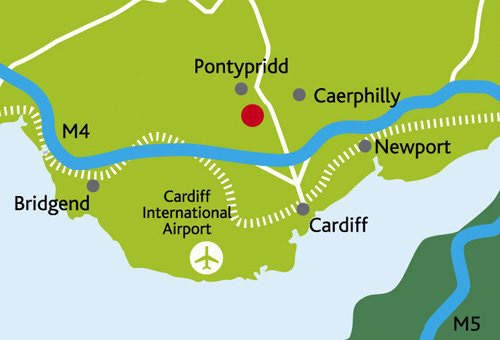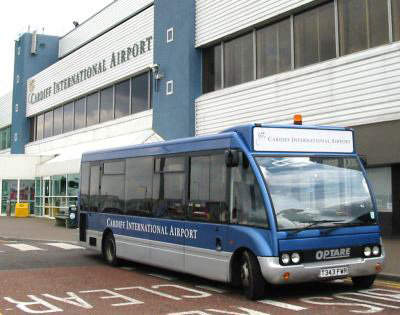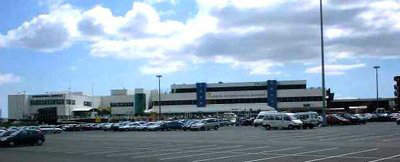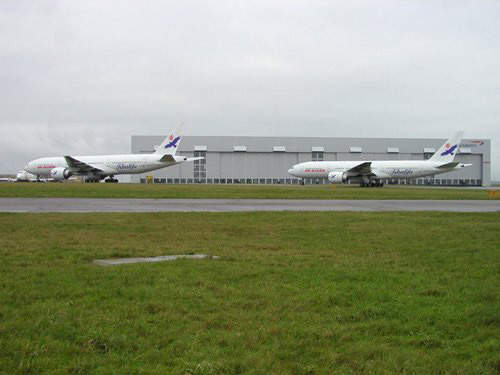Cardiff International Airport (previously known as Cardiff-Wales Airport) is a relatively small international airport located on the outskirts of the village of Rhoose, in the Vale of Glamorgan, approximately 12 miles (19km) south-west of the Welsh capital, Cardiff.
The airport is a major facility for the area serving all business and tourist traffic for south and mid Wales. The nearest comparable international airport is at Bristol.
Cardiff is the only airport in Wales offering international scheduled flights to Europe and the US. The airport is multi-purpose and versatile, being served by scheduled, low-fare and charter carriers and also supporting corporate and general aviation as well as having maintenance facilities too.
The maintenance hangar is one of the largest in the world (at 250m x 175m / 820ft x 574ft) and provides heavy airframe and engineering maintenance for the British Airways fleet and third-party carriers.
CARDIFF INTERNATIONAL HISTORY
Cardiff Airport has been handling commercial flights since 1952 when Aer Lingus started a service to Dublin. In more recent times the airport has had several upgrades; in 1986 the runway was extended by 750ft / 229m (£1m) allowing greater versatility and the acceptance of true international flights from the Boeing 747.
The airport was privatised in 1995 and is owned by Airport Concessions and Development Ltd (ACDL) which took over from the previous owner TBI plc (a subsidiary of Abertis Airports).
AIRPORT EXPANSION
Cardiff currently receives over two million passengers a year and as part of its ongoing infrastructure improvements a new airport baggage hall has been constructed, opened in June 2006.
In March 2007, formal CAA figures showed Cardiff Airport had passed the two million annual passengers mark, and with an annual growth rate of 14% was the UK’s fastest-growing regional airport (25 aircraft movements an hour).
The new baggage hall has cost over £2m and was constructed and outfitted by Midas (based in west-Wales) over a 20-week-long contract starting in late 2006. The new efficient and streamlined baggage hall will now make it easier for the airport to handle more passengers over the coming years.
The new facilities will allow baggage handlers to deal with thousands more suitcases every day, meaning passengers will be reunited with their luggage more quickly. The new 2,000m² hall has been fitted with an international-standard conveyor belt system.
Airport managing director Jon Horne said: “With new routes and increased flights the airport is looking forward to a record year in 2007. The new-look baggage hall will provide us with the capacity to match and even exceed 2006’s growth in passenger numbers, while maintaining a high level of efficiency.”
PUBLIC SERVICE OBLIGATION AND NEW ROUTES
In February 2007 the first Public Service Obligation (PSO) service in Wales was announced. The Inverness-based airline, Highland Airways will fly several services, each day, between Anglesey (RAF Valley) and Cardiff.
BAE Jetstream 31 aircraft have been allocated to the route, which will provide a quicker alternative for commuters travelling from north to south Wales, and those who currently have to rely on the A470 road or rail. The PSO service will be subsidised by the Welsh Assembly Government, for three years; after this the route will have to be completely viable to continue.
In May 2007 the Anglesey service was deemed a success, with over 1,000 seats being booked on the service within weeks of its announcement. Cardiff has key aspirations to develop new routes to Germany, Italy and Scandinavia. A new low-cost airline, called flyforbeans, is due to start 12 new routes to Europe from Cardiff starting in 2007.
CARDIFF AIRPORT MASTER PLAN
In March 2006, a £100m development strategy was announced at the airport which will include expansion of the current terminal, as well as upgrades to the main body of the building and a new multi-storey car park.
The 24-year master plan will hopefully close the gap with rival Bristol International Airport, which has its own long-term expansion plan. The Cardiff plan envisages passenger numbers increasing to around five million by 2015 and eight million by 2030.
Road access to the airport is poor at the current time with only minor roads running near it after junction 33 of the M4 motorway. Improvement of the road access has been met with opposition and a public enquiry in 2006 but this is no longer a problem as the forthcoming Defence Training Academy at RAF Saint Athan, which is to get a direct link to the M4 motorway is near the airport and the link road will serve both.







